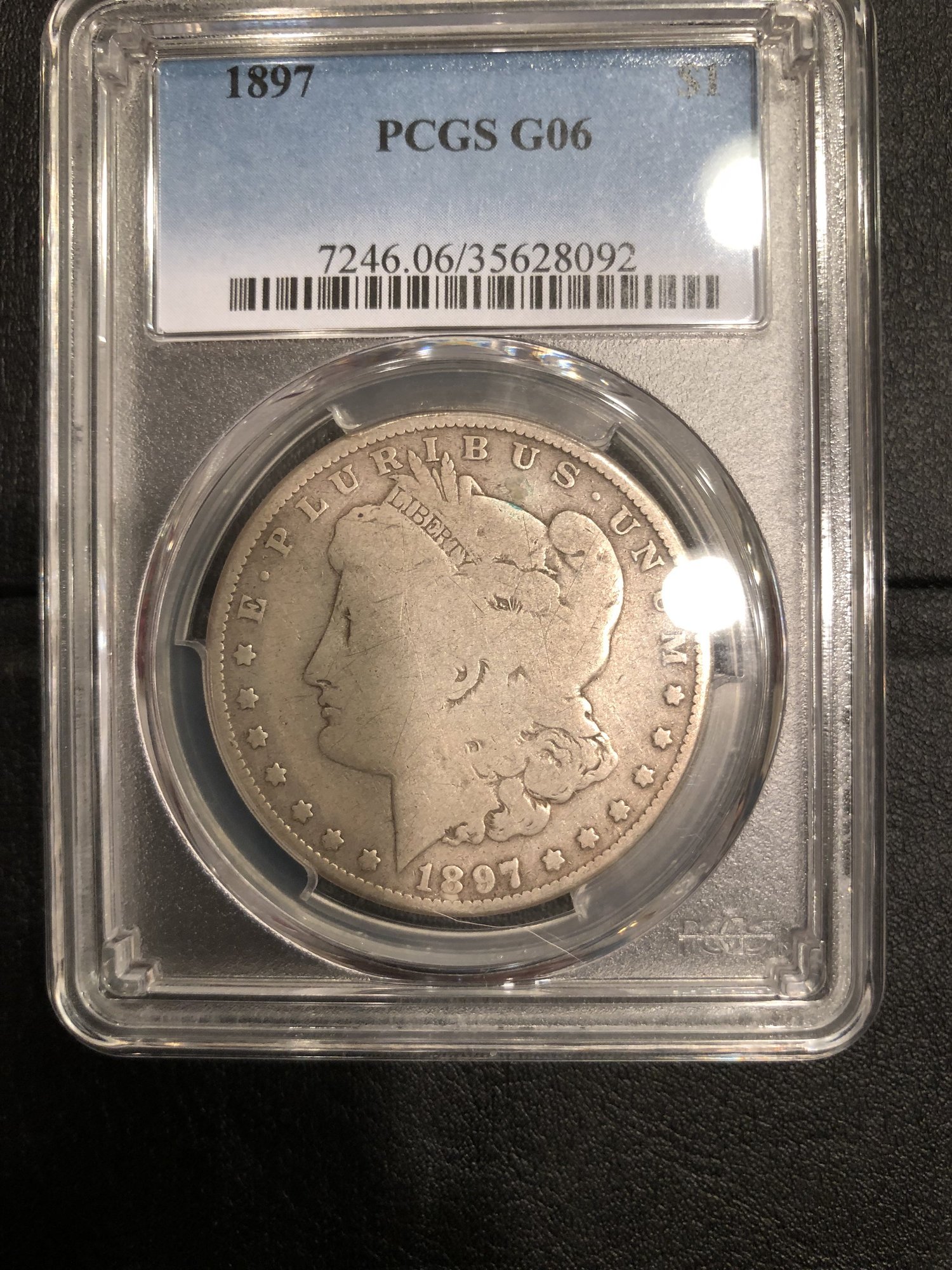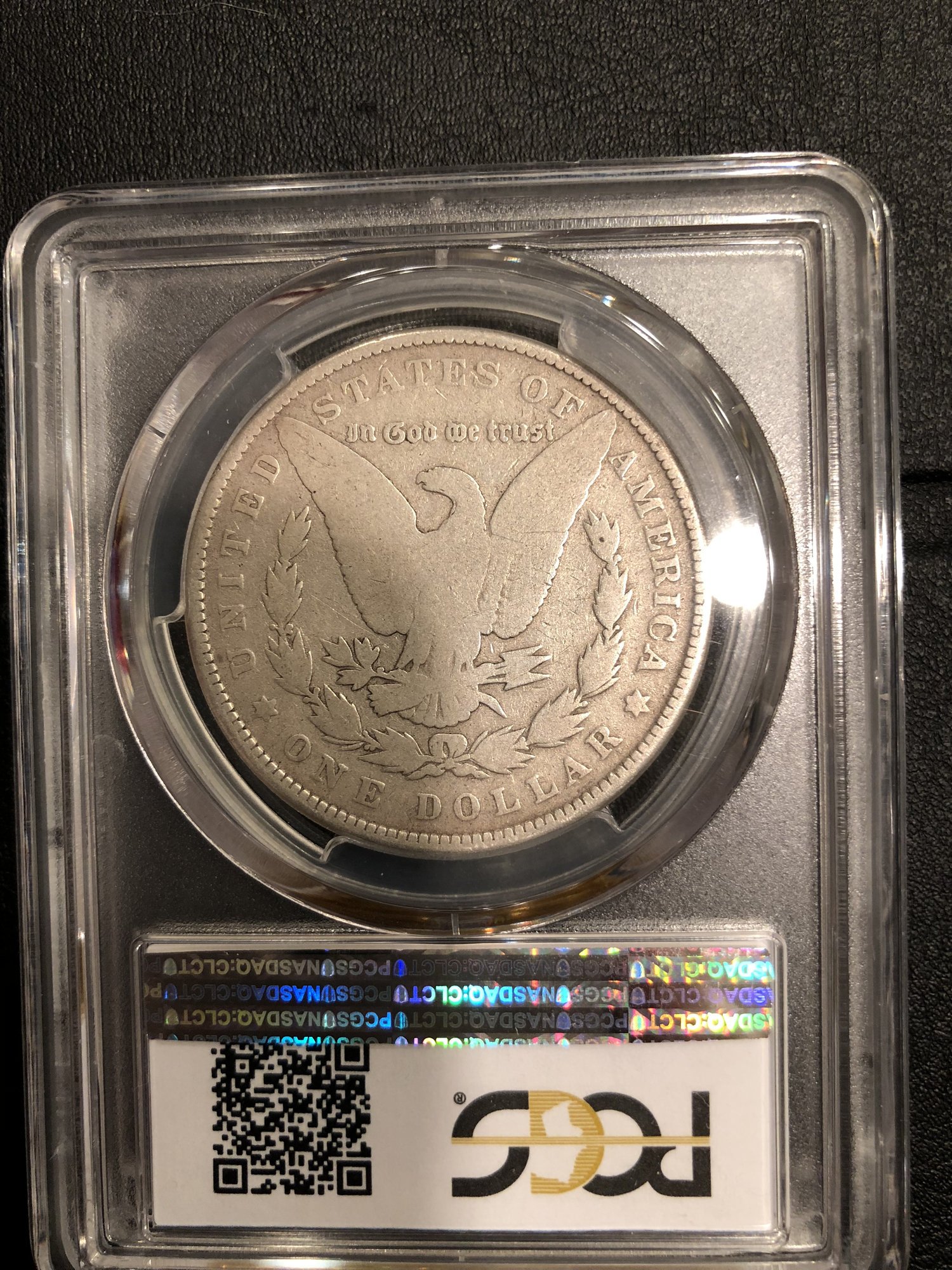Why do some worn Morgans have full rims while other equally as worn Morgan do not?
 braddick
Posts: 24,979 ✭✭✭✭✭
braddick
Posts: 24,979 ✭✭✭✭✭
I've always been puzzled as to why many Morgans will have worn away rim when a coin gets to GD6 or below while a few others will have completely worn away center details yet the rims remain full?
I recently picked this one up off of eBay mainly because I thought the wear pattern was so unusual.


peacockcoins
1
Comments
That is a hard question to answer. I am guilty of often assigning a "Good" grade to coins that don't have full rims. I've always been concerned more with the remaining design. I agree with the grade of that slab. If split grades were still in use it would be a 6/4 IMO.
Now back to your question, perhaps this happens mostly to coins that are weakly struck to begin with.
Could be how they got their wear?
A coin that spent time in pockets and coin purses might wear differently than one that spent it's life in Vegas slot machines? Maybe??
Interesting question.
The coin would make a nice start for a grading set.
Some have problems from the mint on obverse or reverse but most of the time not both. Photo of a mint state coin with weak rim & denticals. Don't know if this would cause what you are seeing after the coin wears down.
I think many Morgan date wearing has to be broken down first by date strike and release first. Also purpose and technology available at time of issue. When did counting machines and slot machines begin to take dollars. When did bank start wrapping coins in rolls with machines and not by hand. Timeline on these thing should be answered. Then was the coins used overseas or local? Just a few questions to consider. When did collectors realize they would have premium value. Post melting Periods silver recalls, hoards. ...
Best place to buy !
Bronze Associate member
Another example from my collection:
peacockcoins
This is where we need the TPG's to start assigning G07+ (sarcasm emogi).
A search on Heritage for "morgan dollar g6" does not reveal a whole lot of variation of rim/denticle wear relative to yours. "mainly because I thought the wear pattern was so unusual" - In fact I don't see any difference at all between yours and a typical G6. Perhaps post a comparison image of what you're talking about?
Interesting
edit to add: ex. jewelry maybe with bezel protection?
Slot machines.
Patrons thumb and finger the coin when sliding it into the machine, they do not hold it by the edges.
You can dispel yourself of the romantic use for silver dollars in Wild West Towns and face this; the biggest user of US Silver dollars was at one time Nevada casinos.
I believe it is mainly a strike phenomena.... True, use in commerce/private possession can produce wear patterns - however, original strike and die conditions are the primary contributors to these patterns. Cheers, RickO
Typical flatly struck coin to begin with.
The mints had to produce silver dollars - not "best quality" - just lots of them. New Orleans had persistent dollar manufacturing difficulties. They were ordered to make more coins than they had the capacity to produce. The bottleneck was in annealing; so quality suffered for decades. (See 1900 engineering review.)
[Also, I strongly suspect a strain of parasitic "Rim Worm" (Annelida chompus peripheratii) infected used silver dollars stored in Treasury department bags.]
I have written elsewhere about how the upsetting mills at the different mints left differently-shaped upset ridges on the planchets, and how this affected the raised rims on the struck coins. Stronger or weaker rims on uncirculaed coins will mean stronger or weaker rims on low grade coins.
I will see if I can find what I wrote.
TD
From a round-robin email discussion with Dave Bowers, Dennis Tucker and others where somebody was trying to answer a collector's question as to why some Morgan dollars appeared thicker than others. After we were done somebody asked for and received my permission to reprint this somewhere, but I do not know if they ever did.
TD
"People tend to measure thickness at the rims, which vary in height above the field, rather than in the center of the coin, because they are afraid of damaging the coin even though the thickness there should be more consistent. Note that on a Morgan dollar the rim has two elements, an inner ring of raised denticles and an outer, solid ring that is higher in relief than the denticles.
Rims on Morgan dollars vary in height because of the different ways that the Mints upset their Type One dollar blanks. The upsetting mills had channels that the blanks were rolled through to push metal inwards and upwards, above the level of the field of the planchet. The sides of those channels had different shapes to them that left different-shaped upset rims on the Type Two Planchets, as seen on a collection of off-center dollars that came through ANACS while I was there. On many of the coins you could identify the Mint and/or the year, or at least get a good idea what time frame it was struck in.
The channels used in New Orleans were relatively flat, which left the highest part of the upset rim close to the border of the planchet. When struck it thoroughly filled in the solid raised ring outwards from the denticles, while sometimes leaving the denticles themselves a little weak. It also left the reeding on the edge of the coin relatively long. Look at the edges on a BU roll of O-mint dollars in a plastic tube and you will see how wide, or thick, they appear.
The CC mills had a relatively deep V in them, which pushed the upset rim further in from the edge. Such coins typically have strong denticles but a weak or even missing outer rim, and the reeds on the edge are short.
The P and S Mints struck a better balance in the upsetting, giving you decent denticles and raised rim, and medium length reeding. Try putting an assortment of BU dollars in a plastic tube and see what I mean.
Hope this helps.
TD"
wouldn't that be like a method of operation? fwiw
The coinage mints had an overriding goal of producing coins that would produce the same height pile of 10 coins - same concept for all gold and silver coins. The upset mills could be adjusted to aid this, and that is much of what CaptHenway refers to.
This is my guess also. Sliding those heavy coins into the slot and then having them slide down a metal chute into the hopper is a different kind of wear than being in a pocket.
The wear to the reeds would also be different. I see these characteristics on JFK halves all the time.